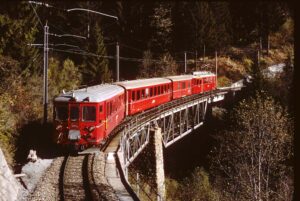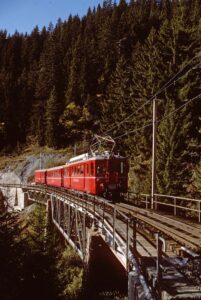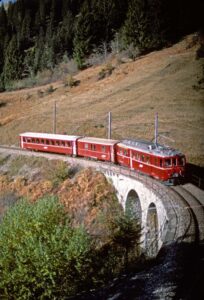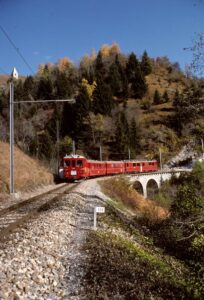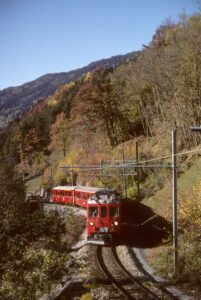The beautiful autumn colours we enjoyed in October motivated me to look for beautiful autumn pictures. Finally, I found what I was looking for in the form of a small series of photographs of the Chur – Arosa railway in its era of direct current operation.
A typical push-pull train as was common from 1969 onwards with the ABDe 4/4 483 + D 4232 + B 2316 + ABt 1703. The powerful railcars were lined up on the mountain side. Due to the different heating voltage, only a small number of trailers could be used. These vehicles were easily recognisable by the roof structures for the heating cable, a rod at one end of the carriage and a cross-sliding piece at the other end. This cross-sliding piece is clearly visible on the railcar above the door. Next to the train, a deciduous tree glows in the most beautiful autumn colours. 6 November 1983 below St. Peter © Photo: Edi Meier, Bülach The same push-pull consist now descending on the viaduct with steel girders below St. Peter: ABt 1703 + B 2316 + D 4232 + ABDe 4/4 483. The same bridge is crossed here by a standard train with the ABDe 4/4 486 railcar + B 2317 + D2 4054. This happened relatively often, because normal operation required all three control cars for three rotations. If one was undergoing inspection or repair, there was no alternative but to carry out laborious detours at both terminus stations. Of the four-axle luggage vans, only three were approved for the journey to Arosa. If necessary, one of the three adapted two-axle carriages (4002, 4004 and 4054) was therefore used. The D2 4004 was even capable of shuttle service! 6 November 1983 below St. Peter © Photo: Edi Meier, Bülach This train is also not in shuttle service on the stone viaduct below St. Peter: ABDe 4/4 485 + D 4233 + B 2318. In principle, only the ABt control car is missing here, which was affordable in the off-season in November. The second shuttle train in service that day is seen descending on the same viaduct: ABt 1702 + B 2319 + D 4231 + ABDe 4/4 488. In the background, the church tower of St. Peter and the larch trees compete for attention. As you can clearly see in this photo, the Chur–Arosa railway follows all the protrusions and valley incisions on the steep slope. It is said that there are as many curves as there are days in the year. However, I have never counted them… The same applies to the road, by the way. The train with ABDe 4/4 486 + D2 4054 + B 2317 surrounded by autumn-coloured trees and bushes on a few metres of straight track between two curves. Due to the lack of a control car, the railcar is at the head of the train on the valley side. When there was a lot of snow, this was sometimes done for safety reasons (heavy vehicle at the head of the train) even with shuttle trains. In the narrow Plessur valley, there are not many hours of sunshine in November, even though the railway runs on the sunny side. It is no coincidence that the villages are located significantly higher than the associated stations and thus benefit from more hours of sunshine. The non-shuttled train with ABDe 4/4 485 + B 2318 + D 4233 briefly emerges from the shadows of the trees into the full evening light. Comments and additions to this railway history can be sent to EG at sgeg dot ch, or use the form to our Vice President Edi Meier. Thank you for your help.
Back to railway stories

